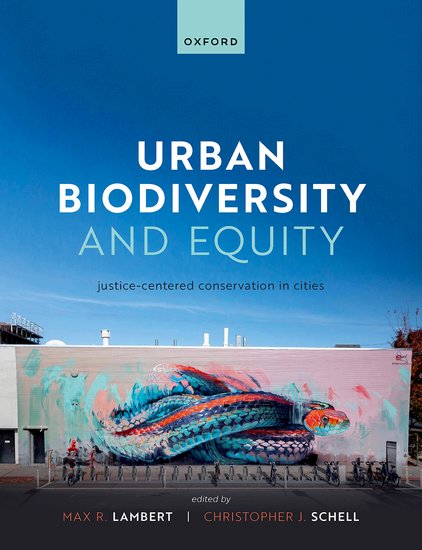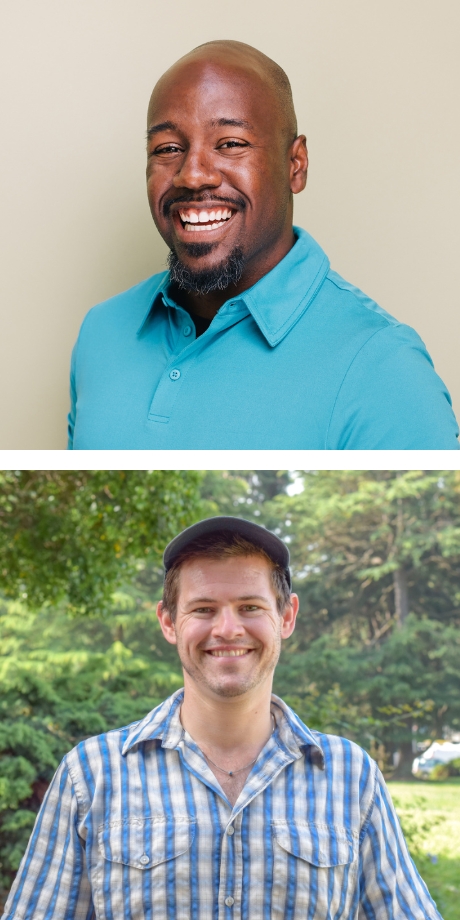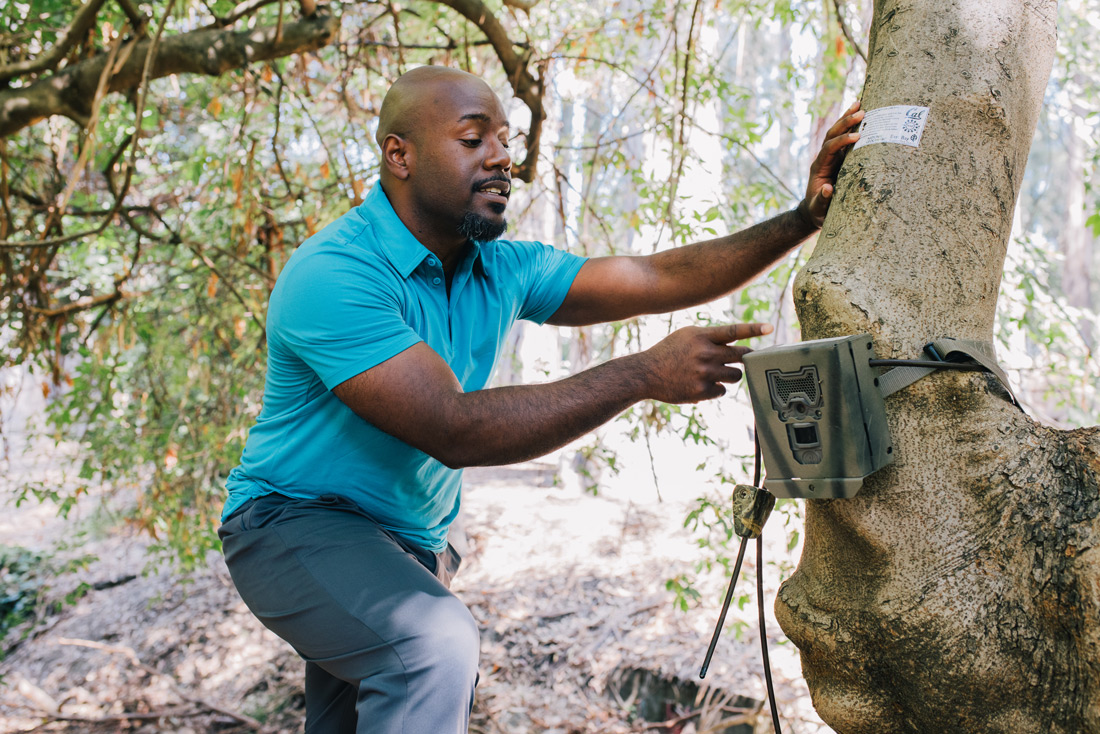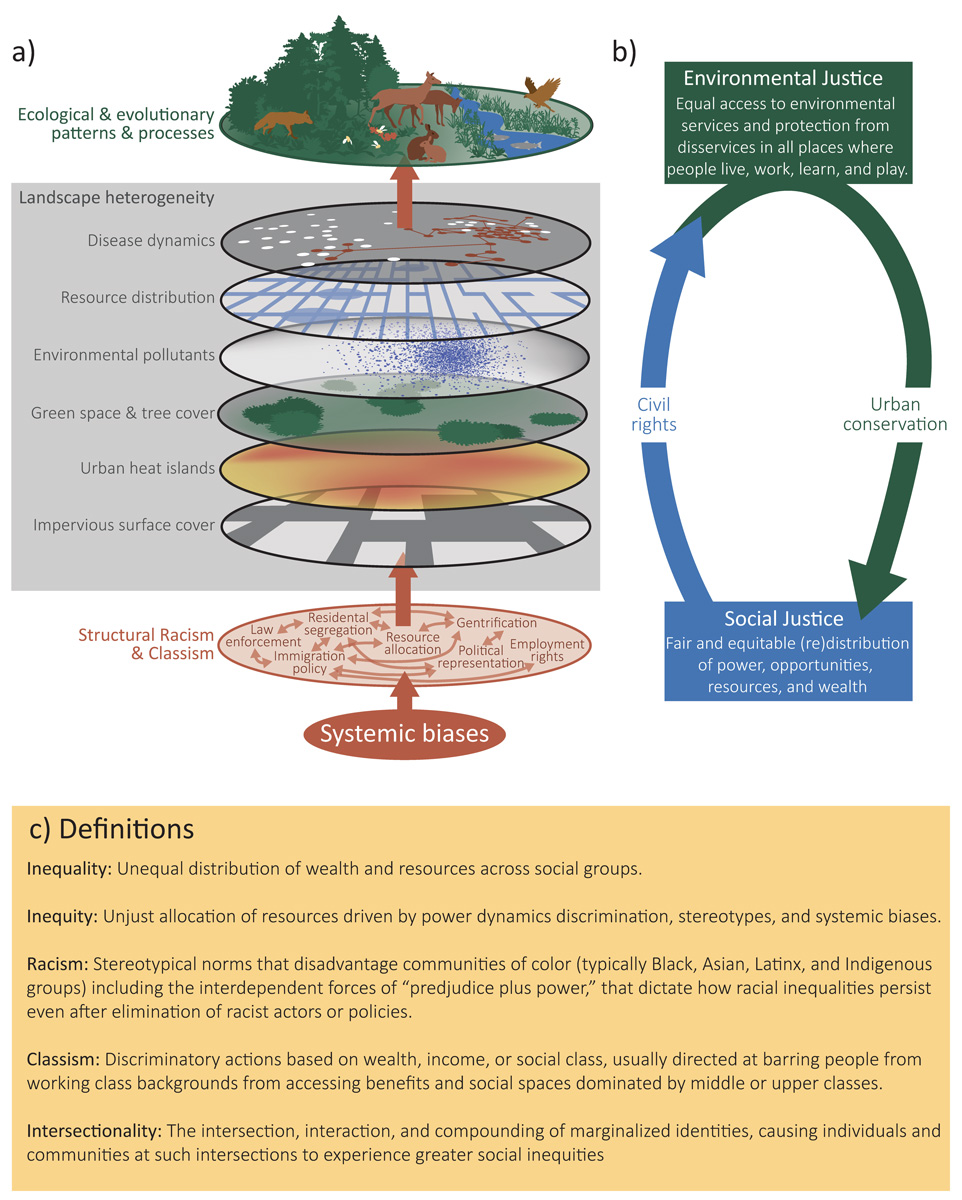Justice-Centered Conservation in Cities

[image caption]
For centuries, cities and urban environments have reshaped biodiversity across the globe. Buildings, roads, and other pieces of urban infrastructure have replaced natural habitats and sources of food, water, and shelter.
Research continues to show that development has created environmental hazards like factories, freeways, or power plants that are often disproportionately placed in low-income areas or communities of color, and that remaining natural resources in urban areas, like trees and parks, are concentrated in wealthier neighborhoods. With renewed attention placed on the role of conservation, researchers are exploring new ways to make cities and their inhabitants active partners in preserving biodiversity and mitigating climate change.
A new book edited by Rausser College researchers delves into the complex elements that support or constrain biodiversity in cities—including human-wildlife interactions, climate fluctuations, landscape diversity, and environmental racism. Edited by Environmental Science, Policy, and Management professor Christopher Schell and former postdoctoral researcher Max Lambert, Urban Biodiversity and Equity: Justice-Centered Conservation in Cities offers scientists, decision-makers, and practitioners a new model to develop solutions for managing urban biodiversity while centering social justice, environmental justice, and civil rights.
Rausser College spoke to Schell and Lambert about their book ahead of its release in the United States.
This conversation has been edited for length and clarity.
What inspired you to create this book?

[image caption]
Max Lambert:
We were invited to put together a book on urban ecology and biodiversity. We knew there were other books out there, but we knew we wanted to write a book through a different lens: specifically, we’re building off a Science paper led by Chris that centers equity and justice as the primary axis for conservation work. That was our guiding principle for taking this from journal publications to something that people can hold.
Christopher Schell:
This is something that Max and I have been discussing since 2018. After our Science paper came out in 2020, Max contacted me to discuss what it would look like to expand that paper as a larger volume. We connected with folks who reached out about the paper and others whose work spans the urban-ecological spectrum to coalesce their contributions into a book that integrates equity throughout.
We didn't want to fall into the trap of thinking that academic institutions somehow have a hold on all this knowledge. Max led our efforts in trying to convey how applied this field is and emphasize the field’s interconnectedness. We were excited to get folks who could span what it looks like to think of these theoretical applications in biodiversity science in relation to a city.
Lambert:
And because urban ecology has blossomed so much as a field during the past 20 years, we spent a lot of time determining what topics we knew we wanted to emphasize in this book and what we would put on the back burner. We also wanted to bring in people from different backgrounds, walks of life, career stages, or parts of the world who can tie the threads of equity and justice together with this science.
How would you say the field of urban ecology has evolved over time?
Lambert:
There have been pockets of people studying urban ecology from the 60s onwards, but their research never became part of the dominant mantra. By the 90s, we had the National Science Foundation (NSF) support two Long Term Ecological Research stations in Baltimore and Phoenix, which helped blossom and lead this area of research. But in my experience, even when I started my doctoral work a decade ago, urban conservation wasn't really a thing—there were still tons of folks saying we needed to protect nature from the city.
Schell: For us, the question is, when do we recognize that urban ecology has entered the public consciousness to the point that folks outside the academic sphere are thinking about it? We’re certainly getting there in the Bay Area, as well as in a handful of cities across the country and globe. Folks in these communities are thinking more and more about their relationships with wildlife, biodiversity, and nature inside these urban spaces. But sometimes folks look at us like we’re crazy when we talk about the critically endangered species that are encased in a metropolitan area, or when we tell them about the large carnivores that roam their backyard. Some people have not yet fully understood that cities are hubs of nature that we created on top of existing biodiversity hotspots.
How does this approach differ from traditional models of conservation research?
Schell: We’re leveraging a past research framework called the ecology in, of, and for cities to propose something called conservation in, of, for, and with cities. We’re still thinking about the many ways in which we maintain biodiversity across different axes; incorporate biological, social, and built elements of cities to manage ecosystem processes; and implement justice-centered approaches as we build sustainable practices. But all that felt unidirectional, where scientists or practitioners are doing things for the people who live in the city.
Conservation in, of, for, and with cities is the new atom. It’s explicitly calling out co-production, how we have equitable resource distribution, and how we fold in the other paradigms. We’re emphasizing that if we don't have conservation with cities, none of the other components are going to work. In our minds, this is the linchpin to all those other pieces. We’re not the only knowledge holders in this conversation, and by no means do you need to be of a certain age, race, class, or ethnicity to participate in it. We’re all in this together and have something to add to the conversation.
Lambert: You can’t do conservation work without cities. You can’t grey out urban areas and focus conservation work elsewhere. It’s all part of the mix. Conservation with cities means engaging in conservation work at any scale—from state to national to international. You can’t set goals just for remote places; you have to bring them into urban areas as well. All this goes back to our fundamental principle of centering equity and justice in all conservation. It is heavily pronounced in urban areas, but it's central to conservation work anywhere in the world.
Ecology and evolutionary biology are fundamental fields of biology, but they don’t exist in a vacuum. Our Science paper showed that we need to be mindful of how society, culture, and politics influence life on Earth. We’re doing the same thing here with conservation.
Can you think of any people, cities, or organizations that are taking the principles you describe in your book and using them to improve urban biodiversity?
Schell: Max and I often riff off of Singapore being the mecca of urban ecology because of how that city is designed and embedded inside of nature, but we’re starting to make improvements on the West Coast, too. One of the local organizations that has been pushing urban ecology forward is the California Academy of Sciences. Their Reimagining SF initiative brings together researchers and practitioners from across the Bay Area to think about San Francisco not as an urban environment with nature sprinkled in, but as a city inside of nature—one built in collaboration with ecosystem processes. It’s a clear departure from the ways in which cities have thought about urban ecosystems in the past, which was strictly concerned about providing municipal services to its people.
Lambert: I went to Canberra, the capital of Australia, in 2016. It's a highly built place, but they’ve embedded trails and green spaces throughout the city; there are kangaroos, wallabies, and all kinds of parrots everywhere. It’s very clearly designed, as Chris said, in collaboration with nature. The Presidio of San Francisco has also been an interesting nexus of urban conservation work. The Presidio Trust, which manages the park with the National Park Service, has done tremendous work with communities nearby. They’ve replaced non-native plants that have overgrown the area, cleaned up a bunch of pollution in the pond, and reintroduced endangered plants within the Presidio.

[image caption]
I also work closely with the City of Tacoma in Washington. Maintenance workers—the folks who take care of the concrete, asphalt, and sewers—are not the type of people you traditionally think of as doing conservation work, but in Tacoma, they are so impassioned to make sure biodiversity can thrive, and people can experience it everywhere they live.
Have you found engaging with policymakers or community members difficult while conducting your research?
Schell: The flagship species that my lab studies is coyotes, a species that garners a lot of interest in the Bay Area. In SF, a good chunk of folks have a real love-hate relationship with them. They think that their cats have some agency to stay outdoors indefinitely or that their dog can stay off-leash in an on-leash area, which often results in conflicts with coyotes. And as we start doing more of this work, it seems as if everybody has a story about a coyote—or a bobcat, raccoon, or a fox—doing something they adore or disdain.
These fine-scale human-animal interactions bring everybody to the table. They want to hear more about how these are connected to the larger universe of stories around urban biodiversity, environmental justice, equity, and resilience because it impacts them at this individual level.
Lambert: Maps will become essential to these conversations and are what entice people to join. For so long, the image of conservation was just David Attenborough in the middle of the world somewhere, in a place we can't necessarily relate to. But now, I can set up a map on iNaturalist that everyone can contribute to and access for free. Whether it’s a map of all the trees in their city or observations of turtles, frogs, or hawks, people will be able to put themselves in the context of their city. They can actually paint that picture of the landscape—they can see the asphalt, they can see trees—and place their community in the broader grand scheme of the universe.

[image caption]
Schell: One of our flagship projects deploys camera traps across urban to wildland spaces. We put up placards that give out our contact information if people are interested in the project; we've had over a dozen people in the last year reach out to us who are interested in learning more about the camera traps, including city officials. A figure from our Science paper created by co-author Dr. Simone de Roches was recently republished in the New York Times, and after reading that, some folks from the City of Piedmont’s Recreation Department reached out. This small example highlights how far-reaching and continually helpful the work has been in creating collaborations across the Bay
Lambert: I think that’s the power of urban areas for conservation and getting people engaged. They know where they fit into much more easily than if you were to ask, “How do we protect tigers in Mumbai?” It matters in the grand scheme—people generally care about tigers—but they have no context for it. People have context for their backyard coyote: almost everyone has a story about something in their urban area; they're just looking for someone to tell it to.

[image caption]
Do you think it’s possible to create policies that improve urban biodiversity without first addressing the inequities like redlining?
Lambert: There are two panels to the figure that was just republished in the New York Times. The panel on the right shows conservation embedded in a cycle of social justice, environmental justice, and civil rights: that’s the foundation for which successful conservation efforts will ever be possible. You can try to chip away at it in small ways, but you will always fight an uphill battle unless you center equity and justice because the things that cause injustice and inequities also degrade the natural world. These things are inherently intertwined.
Schell: If we can't figure ourselves out and figure out how we got to this point while centering equity and justice—which is something we said in the Science paper and at the beginning and end of this book, and also urged all of our co-authors to talk about it—then we will never get to our goals. This book was something that we wanted to get out into the world because this is not something we’re alone in; there are other folks who are also interested in this, who also feel the same way, and who have been beating this drum in their communities. It’s been a good journey to be able to put this into words and have folks understand how important it is to be able to restore ourselves as a means of then going on to continue to restore the natural world.
Read More
- Toward a New Legacy (Breakthroughs magazine)
- Fostering coexistence with San Francisco’s urban coyotes (Rausser College of Natural Resources)
- Systemic racism has consequences for all life in cities (University of Washington)
- The ecological and evolutionary consequences of systemic racism in urban environments (Science)
